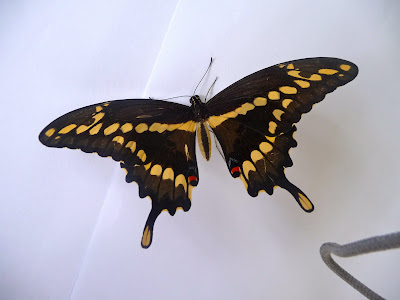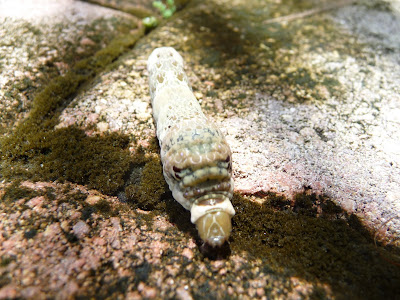Saturday, February 16, 2013
Friday, July 22, 2011
Friendly Frog
Check out this cute little guy I found climbing up the exterior of my house late one night. I'm not sure what species of frog this is, but I noticed it has three toes.
Labels:
frogs,
nature,
three-toed frog
Saturday, October 2, 2010
The Tiniest Pet on the Planet - A Story of Sacrifice and Survival

My pet is fuzzy and cute and less than an eighth-of-an-inch long. You could fit him on the tip of your fingernail. He's an Orange Dog caterpillar who lives in the Meyer Lemon Tree in my backyard and one day he will turn into a beautiful Giant Swallowtail Butterfly. The story about how he came to my tree is both tragic and inspiring.
One day I saw a Giant Swallowtail Butterfly float past my window. I went outside and observed it alighting on the leaves of the lemon tree. After several minutes it stopped on one leaf for a few seconds and suddenly plummeted to the ground. A lizard lurking in the tree apparently thought it saw lunch and delivered what would be a fatal blow to the butterfly. The swallowtail lay helpless on the ground, frantically flapping its exquisite wings patterned with brilliant lemon-yellow, blue, red, and black colors. On the leaf where it had fallen from was a tiny orange egg!
I tried to nurse the swallowtail to health but in a few days it passed away. In creating life, this lovely butterfly lost her own, making the ultimate sacrifice. In her honor I put her in my freezer so that she will be preserved for eternity.
For five days I observed the egg. Despite a tropical storm, it remained stuck to the leaf of my lemon tree. On the sixth day, I discovered the Orange Dog caterpillar on the leaf. It apparently had just emerged because part of the egg was still on the leaf. I took several photos and when I returned a few hours later, it had moved on. If he survives, he will live in that tree, eating the citrus leaves until it forms a crysalis to prepare for metamorphosis.
One day soon my tiny friend won't be so tiny anymore. He'll grow up to be a beautiful butterfly and float away into the great wide world.
Labels:
butterflies,
Giant Swallowtail butterfly,
Orange Dog
Saturday, September 25, 2010
Metamorphosis
 A few weeks ago we found signs that something was munching on the leaves of the Meyer Lemon tree in our backyard. The culprit, it turned out, was a strange-looking caterpillar called an "Orange Dog" (because of their appetite for citrus tree leaves) that would one day make a marvelous transformation into a Giant Swallowtail Butterfly.
A few weeks ago we found signs that something was munching on the leaves of the Meyer Lemon tree in our backyard. The culprit, it turned out, was a strange-looking caterpillar called an "Orange Dog" (because of their appetite for citrus tree leaves) that would one day make a marvelous transformation into a Giant Swallowtail Butterfly.In my screened-in porch, I created a habitat of leaves and sticks in a tray for the caterpillar and a few days later it formed a chrysalis on one of the sticks. Within the chrysalis, which looked just like a dead branch, the caterpillar would make its metamorphosis over the next 14 days.
One morning I walked out on my porch and there it was, a stunning Giant Swallowtail Butterfly! At some point earlier that morning, it had emerged from the chrysalis and flew up onto my screen, where it was drying its delicate wings in the sunlight. The next day, it flew out into the world, landing on our bougainvillea blooms before fluttering off into the bright blue sky.


Labels:
Butterfly,
Giant Swallowtail,
Orange Dog
Sunday, September 12, 2010
Rare sighting: Cuban Pewee in the Everglades
This Saturday I saw a rare Cuban Pewee at Everglades National Park, a once-in-a-lifetime experience that I will be able to treasure for years with beautiful photos and video thanks to Jeff Bouton, my guide and photography expert. The Pewee was spotted about a week ago, the first sighting in the park ever and only the third sighting of this species in North America.
 The Cuban Pewee, a resident of northern Bahamas and Cuba that lives in pine forests, mangroves, and swamp edges, is a small gray flycatcher with a dark head, orange bill and telltale white crescent behind the eye. The one that I saw in the Long Pine Key forest in the Everglades flitted about from branch to branch in the same area for a good part of the afternoon, enchanting a group of a dozen or so birders staking it out, with its distinctive call "dee, dee, dee, dee." Its wings looked a bit ragged and worn but it was a very active little thing!
The Cuban Pewee, a resident of northern Bahamas and Cuba that lives in pine forests, mangroves, and swamp edges, is a small gray flycatcher with a dark head, orange bill and telltale white crescent behind the eye. The one that I saw in the Long Pine Key forest in the Everglades flitted about from branch to branch in the same area for a good part of the afternoon, enchanting a group of a dozen or so birders staking it out, with its distinctive call "dee, dee, dee, dee." Its wings looked a bit ragged and worn but it was a very active little thing!The bird was first discovered in the Everglades by birding guide Larry Manfredi. There was a story in the Miami Herald about the sighting: link here.
I was at Everglades National Park with a group of birders from the Tropical Audubon Society. The group was led by Jeff Bouton, an expert in digiscoping, a photography technique that combines the use of a digital camera with a scope. With Jeff's help, I was able to take some amazing photos of the Pewee as well as other birds in the South Dade area that morning. I posted some photos here. Not all of them are digiscoped, some are regular photos off my digital camera.
What an amazing day!
Digiscoped Video of Cuban Pewee at Everglades National Park

Cardinal (digiscoped)
 European Starling (digiscoped)
European Starling (digiscoped) Everglades National Park, Coe Visitor Center
Everglades National Park, Coe Visitor CenterWildlife Wonders out West
 Our trip out West in August was packed with wildlife adventures. We visited Wyoming and South Dakota, with stops at Badlands National Park, the Black Hills, Mount Rushmore, Yellowstone National Park, and the Grand Tetons, as well as Jackson Hole.
Our trip out West in August was packed with wildlife adventures. We visited Wyoming and South Dakota, with stops at Badlands National Park, the Black Hills, Mount Rushmore, Yellowstone National Park, and the Grand Tetons, as well as Jackson Hole. We saw Elk, Buffalo, Bighorn Sheep, Coyote, Black Wolf, Antelope, Prairie Dogs and Moose. We also saw lots of birds, including rare Trumpeter Swans as well as Bald Eagles, Golden Eagles, Osprey, Western Grebes, Mountain Bluebirds, Pine Siskin, Sora, American Three-toed Woodpeckers, Red-naped Sapsucker, and Black-billed Magpies among many others. The butterflies and wildflowers were abundant!

 Bighorn Sheep, Badlands National Park, SD
Bighorn Sheep, Badlands National Park, SD
 Black-billed Magpie, Jackson Hole, WY
Black-billed Magpie, Jackson Hole, WY

 Bighorn Sheep, Badlands National Park, SD
Bighorn Sheep, Badlands National Park, SD Black-billed Magpie, Jackson Hole, WY
Black-billed Magpie, Jackson Hole, WY
Subscribe to:
Comments (Atom)










































